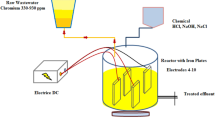Abstract
Tannery wastewater can cause severe environmental problems related to its high chemical oxygen demand, high biochemical oxygen demand, high total suspended solids, high oil and grease contents together with the elevated chromium concentration and objectionable color. The one-step electrocoagulation process was carried out to simultaneously remove chromium and various pollutants from tannery wastewater at ambient temperature in the laboratory scale. Low-cost commercial iron plates were employed in this study as anodes and cathode materials. Effects of various parameters were investigated including types of electrode configuration, initial pH of wastewater (7–9), current density (15.7–24.6 Am−2) and circulating flow rate of wastewater (0–3.67 lmin−1). The optimum condition was found by applying the mono-polar electrode in a parallel connection at the current density of 22.4 Am−2, flow rate of wastewater of 3.67 lmin−1 and 20 min electrolysis time. The initial pH of wastewater ranging from 7–9 provided the similar removal efficiency. At optimum condition, more than 95% of chromium and pollutants except TKN and TDS were eliminated from the wastewater and the properties of the treated wastewater met the standard and permitted to discharge into the environment. The required energy consumption at optimum condition was less than 0.13 kWhm−3 wastewater. In addition, the COD reduction was fit very well with the first-order kinetics model.
Similar content being viewed by others
References
D. H. Ahn, Y. C. Chung, Y. J. Yoo, D.W. Pak and W. S. Chang, Biotechnol. Let., 18(8), 917 (1996).
K. Vijayaraghvan and D. V. H. Murthy, Bioprocess Eng., 16(3), 51 (1997).
M. Wiemann, H. Schenk and W. Hegemann, Water Res., 32(3), 774 (1998).
C. Di Iaconi, A. Lopez, R. Ramadori and R. Passino, Environ. Sci. Technol., 37, 3199 (2003).
G. Farabegoli, A. Carucci, M. Majone and E. Rolle, J. Environ. Manage., 71, 345 (2004).
S.G. Schrank, H. J. Jos, R. F. P. M. Moreira and H. Fr. Schröder, Chemosphere, 50, 411 (2003).
G. Sekaran, K. Chitra, M. Mariappan and K.V. Raghavan, J. Environ. Sci. Health A, 31, 579 (1996).
S. Dogruel, G. E. Ates, B. F. Germirli and D. Orhon, J. Environ. Sci. Health A, 39, 1705 (2004).
C. Di Iaconi, A. Lopez, G. Ricco and R. Ramadori, J. Anal. Environ. Cultur. Herit. Chem., 91, 587 (2001).
D. Orhon, S. Sšzen, E. Ubay Cokgšr and E. Ates, IAWQ 19th Biennial International Conference, 256 (1998).
Z. Song, C. J. Williams and R.G. J. Edyvean, Desalination, 164, 249 (2004).
H. S. Shin and J. K. Lee, Korean J. Chem. Eng., 23, 188 (2006).
S. H. Shin, Y. H. Kim, S. K. Jung, K. H. Suh, S.G. Kang, S. K. Jeong and H. G. Kim, Korean J. Chem. Eng., 21, 806 (2004).
G. Chen, Separ. Purif. Technol., 38, 11 (2004).
J. Naumczyk, L. Szpyrkowicz, R. De Faveri and F. Zillio Grandi, T. I. Chem. Eng. B, 74, 59 (1996).
L. Szpyrkowicz, J. Naumczyk and F. Zilio-Grandi, Water Res., 29, 517 (1995).
A.G. Vlyssides and C. J. Israilides, Environ. Pollut., 97, 147 (1997).
L. Szpyrkowicz, H. Geoffery, N. Santosh and M. De Faveri, Chem. Eng. Sci., 56, 1579 (2001).
G. Rajalo and T. Petrovskaya, Environ. Technol., 17, 605 (1996).
M. Murugananthan, R.G. Bhaskar and S. Prabhakar, Separ. Purif. Technol., 40, 69 (2004).
M. Ali Awan, M. A. Baig1, J. Iqbal, M. R. Aslam and N. Ijaz, Electron. J. Environ. Agr. Food. Chem., 2 (2003).
G. Tiravanti, D. Petruzzelli and R. Passino, Water Sci. Technol., 36, 197 (1997).
T. Panswad, O. Chavalparit and C. Chandung, Waste Manage. Res., 19, 450 (2001).
APHA, AWWA, WEF. Standard Methods for the Examination of Water and Wastewater, 20th ed. Part 3111 B (1998).
S. Kongkao, A Thesis Submitted in Partial Fulfillment of the Requirements for the Degree of Master of Science Program in Chemical Technology, Department of Chemical Technology, Faculty of Science, Chulalongkorn university, Bangkok, Thailand (2005).
M.Y. A. Mollaha, P. Morkovskyb, J. A. G. Gomesc, M. Kesmezc, J. Pargad and D. L. Cockec, J. Hazard. Mater. B., 114, 199 (2004).
C.Y. Hu, S. L. Lo and W. H. Kuan, Water Res., 37, 4513 (2003).
J. Q. Jiang, N. Graham, C. Andre, G. H. Kelsall and N. Brandon, Water Res., 36, 4064 (2002).
T. H. Kim, C. Pak, E. B. Shin and S. Kim, Desalination, 150, 165 (2002).
M. Hunsom, H. Vergne, P. Duverneuil, K. Pruksathorn and S. Damronglerd, Proceeding of 6th World Congress of Chemical Engineering, Melbourne, Australia (2001).
B. Ram, P. K. Bajpai and H. K. Parwana, Proc. Biochem., 35, 255 (1999).
P. A. Balakrishman, A. Arunagiri and P.G. Rao, J. Electrostat., 56, 77 (1999).
S. Kongjao, S. Damronglerd and M. Hunsom, Korean J. Chem. Eng., 24, 730 (2007).
Author information
Authors and Affiliations
Corresponding author
Rights and permissions
About this article
Cite this article
Kongjao, S., Damronglerd, S. & Hunsom, M. Simultaneous removal of organic and inorganic pollutants in tannery wastewater using electrocoagulation technique. Korean J. Chem. Eng. 25, 703–709 (2008). https://doi.org/10.1007/s11814-008-0115-1
Received:
Accepted:
Published:
Issue Date:
DOI: https://doi.org/10.1007/s11814-008-0115-1




